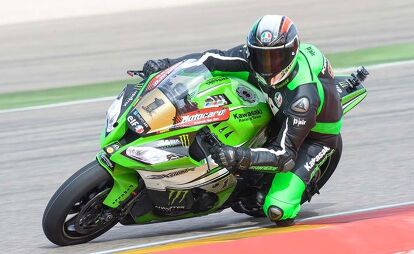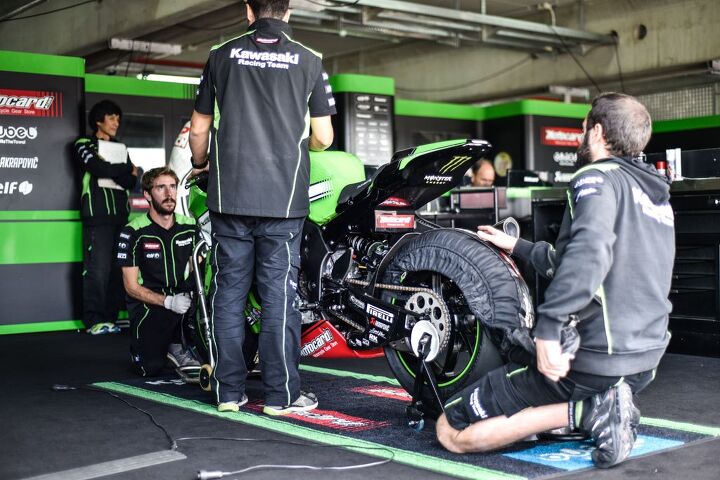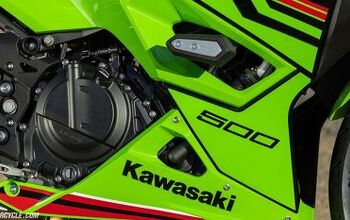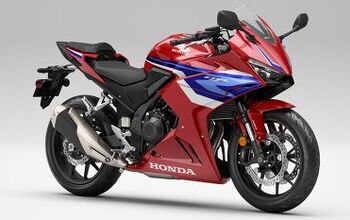Riding Jonathan Rea's Kawasaki ZX-10R Superbike
Yes, a championship-winning World Superbike is as good as you think it is!
Its 2:23 am and I am lying in bed wide awake. I have my hotel window open and I am listening to the rain coming down. Just two weeks earlier if you’d told me I was going to be in a tiny hotel room in Alcaniz, Spain, I would have laughed. But that’s where I am, and I am filled with so many different emotions. Different emotions because I am here as a guest to ride World Superbike Champion Jonathan Rea’s Kawasaki at one of my favorite tracks, Aragon.
As a racer I was always hopeful that I would get a chance on a proper World Superbike. I dipped my toe in the series in 2008, and even though the team I was on wasn’t run very well, I still enjoyed my time getting a taste of the championship I always wanted to race in. Now, I was here in a different role. Kawasaki USA asked me if I would be interested in coming to ride the bike that dominated this years series and do a write up on it. Without hesitation I cancelled everything and boarded a plane to Spain. What was going to make this trip even cooler was the fact that Dainese was going to send my new D-Air suit from Italy right to my hotel — I was feeling factory already!
In the days leading up to my arrival, I was instructed on how this was all going to work. Each journalist (10 of us), were allotted two riding sessions of 15 minutes each. We were going to run the setup that Jonathan used to win one of the races at Aragon earlier in the year. There would be no setup changes or special requests. We would ride rain or shine. The one thing I heard the most, and rightly so, please don’t crash the bike!
Added into all this was the fact that 2013 WSB Champion Tom Sykes would be testing during our time on the track. He was there to shakedown the new 2016 ZX-10R. Rea and his wife were expecting their second child, so the champ was unable to be there. We would go to the track the night prior to our test and eat with the team in the hospitality unit at the circuit.
The Team
One thing was obvious to me from the moment I arrived for our dinner the night prior, this team was organized. When dinner was served, the whole team came in from the garage and headed straight to the buffet. Afterwards, my girlfriend Jamie and I, along with the others involved in our test, went and served ourselves. We were lucky enough that marketing and PR director Biel Roda sat with us during dinner. I learned a lot about how the team originated, starting in World Supersport with Joan Lascorz. Some may remember that Joan was critically injured in an accident in Imola, Italy in 2013. The team still remains loyal to him and has been instrumental in his recovery — it was cool to hear that. Biel also went on to tell us that the majority of the team has been together for the long haul, and you could see that by the way they interacted with each other.
The side of the garage I was interested in was Rea’s. To be as successful as he was this year it takes an unreal team. Pere Riba is a name I was familiar with. A very accomplished racer in his own right, Riba seemed to be the perfect fit for Jonathan. Talking to him about the 2015 season, you can see the admiration he has for the man riding his bike. He explained the team changed hardly anything from race to race, a click here and a click there was how he described it. From the first test, a trust was built, and it carried them throughout the year. And what a year it was! In 26 races, Rea and his team won 14, was on the podium an astounding 23 times and took two pole positions. Add to that, Rea won the Pirelli fastest lap time award for turning the fastest lap of the race 11 times this season.
Talking about the rest of the guys on the team, Riba was quick to point out that not one mistake was made amongst the guys working on the 65 machine. He has great admiration for his assembled crew, and I could tell that he wanted to take little to no credit for how the year turned out. As a rider, you need to have a crew that is like family. I could see with this group that they all have each other’s backs. When that bike rolls into the garage, each guy jumps on the bike to handle the job they need to do, and they do it well. Riba was also quick to point out to me how well Jonathan treats them, always thanking them for the job they do and the hours they spend to help him be successful. This is a team that could do some damage for years to come.
The Bike
When the morning came and we left the hotel, the ground was wet but the sun was out. Arriving at Aragon just before 8 am, it looked like we were going to have a day where the rain stayed away. At 8:30 we were once again in the Kawasaki hospitality unit to receive instructions as to how the day would go. Team manager Guim Roda thanked everyone for being part of the day and traveling from all over the world to be there. Because of the rain they made some adjustments so we could all have some dry track time. The bad part was everyone was only going to get one go-round on the bike. However, seeing as two people had traveled such a long way, they were going to grant them two 15-minute sessions. I am proud to say that I was one of the two, alongside former MotoGP and WSBK rider Shinya Nakano.
I did my pictures with the bike prior to riding it. During that time I was able to have a look at how the bike would fit my stature. Being a bit bigger… okay, a lot bigger than Jonathan, I was worried how I was going to fit on the ZX-10. I have been doing a fair amount of laps at home on a stock ZX-10, and when I jumped onto the race bike, I could tell right away I was stepping onto something special. The first thing I noticed was how wide Jonathan runs his bars. Watching him ride he sits very forward against the tank and in pictures, his arms and hands look very relaxed. The cushion on the seat helps to keep his weight forward also. I was a bit cramped on the bike but nothing I couldn’t ride with.
When the time came to jump on the bike, I received a few last-second instructions from Oriol Pallares, Rea’s chief mechanic. When you look at the cockpit area of the bike, there are buttons everywhere. We weren’t going to have to worry about any of that stuff today. The team made it easy to just get on and ride. We wouldn’t have to worry about changing maps, TC or even pit lane speed limiter, even though it was all there and easy to get to. The other instruction was we wouldn’t need to use the clutch after leaving pit lane. The bike has auto-blip downshifting, which would prove difficult for an old-school guy like me.
As I rolled out of pit lane for my initial 7 laps, I couldn’t believe how light and nimble the bike felt, even at slow speed. I knew that as my pace picked up it would only get better. My first initial laps would be getting used to the power, or so I thought. This bike was so easy to ride and the power came on so smooth, I felt like I could get up to a reasonable speed right away.
Three laps in and I started to use the Brembo brakes a bit more. I loved the feel the bike had under heavy braking, but I never used the brakes anywhere near their maximum my first run out. Shifting the ZX-10 was shockingly smooth. As I mentioned, the bike has auto-blip, which I have used before. However, even with auto-blip, the bikes I have run in the past still have the ability to use the clutch. When you attempt to use the clutch on Rea’s bike, though, it confuses the Magneti Marelli system the team uses for their electronics. This causes problems managing the engine braking. For years I have used the release of the clutch as a way of helping me set entry speed. The simple inability to release a clutch lever made things a bit different and awkward for me. I know that if I had 30 laps on the bike I could get used to it and it would make things even more simple.
I never thought about tire grip my first run out because, honestly, I wasn’t going fast enough. That said, I could feel the bike was undersprung for me, and that was confirmed via Riba the second he looked at the data. I think I have about 30 lbs on Rea, so the poor bike must have wondered what was going on.
As I prepared for my second run on the bike that afternoon, it just started to drizzle. But it left as quick as it came, and the track would be dry for my next run. I cannot express to you how awesome Pere, Oriol and Arturo Perez were to work with. As the bike rolled in, I noticed right away they were making a spring change for me. This was something I wasn’t expecting, but Pere had seen that I needed a stiffer spring and they just did it. It may not have seemed like much to them, but it was well appreciated.
My first lap out I focused on getting up to speed a bit quicker and wanted to try to get used to the auto-blip feature a bit more. One on the things that made downshifting hard was the bike went into gear so smooth, you couldn’t feel it. So, not only was I not using the clutch, I couldn’t tell what gear the bike was in. Again, this was just new to me, and talking with Riba after, he told me that this is something that he has heard before. Going from 6th down to 3rd at the end of the long back straight became easier for me. Going from 5th down to 2nd on the front straight was harder, though, because I couldn’t feel the shift through 3rd gear. This caused me to constantly double check the instruments to see if I was in the gear I was looking for. I felt almost like a new trackday rider, but I loved the challenge of something new again. My speed increased, and the rear spring helped a bit.
The traction control on this bike was something I was looking forward to feeling. I’ve heard these bikes at full song at Laguna Seca earlier in the year. As Rea picks up the throttle, you can hear the bike doing something more than traditional traction control. The race team can control via the ECU how the cylinders fire, allowing them to manage the power better on corner exits. I was curious to see if this caused any disconnect between a rider’s right wrist and the rear wheel. It doesn’t!! Other than the sound of the bike, I had complete control over the rear wheel, and the traction control was as unobtrusive as it could be. So smooth, so nice.
Stock vs. Super
Ten years ago if you were to look at a bone stock 1000 and compare it to an AMA Superbike, you would see a ton of differences. When you rode them, they wouldn’t seem like a the same bike.
Today, the stock ZX-10 I ride at home does everything well. For me to reach the potential of what it offers takes all of my 30 years of experience. Manufacturers have made massive upgrades to their sportbikes in recent years, mostly in electronics but also chassis and weight distribution. The technology passed down through racing has been extraordinary. The level of a bone-stock ZX-10 and Jonathan Rea’s World Superbike ZX-10 are closer than they have ever been.
What are the biggest differences? Suspension on my stock bike is good, but nothing compared to the factory Showa stuff on the Superbike. This is one obvious thing that most racers will notice right off the bat. Is stock suspension bad? Absolutely not! The more you push, you tend to run out of adjustments, and that’s when getting that fork kit and rear shock will benefit you.
Electronics have come a long way in a fairly short time. Stock bikes are coming with quickshifters, slipper clutches, traction control, launch control, engine braking management and ABS. All of those are great things for the consumer and will make their riding safer. How much you decide to include all that in your riding is something people will work out for themselves. I tend to not run much of anything on the stock bike. When I jumped onto the Superbike, all of that stuff had been sorted to how Jonathan rides his bike. It was amazing to me how the electronics smoothed the ride out — I couldn’t feel the TC and never felt the bike slide.
Chassis-wise, one of the biggest things you will notice between the two is the swingarm. The superbike swingarm is longer and more rigid than the stock bike’s. This is one of the lessons learned in racing that is passed down to the 2016 ZX-10R. The superbike turned quicker than expected and just felt more sorted.
Which brings us to the motor. The power delivery on my stock bike is very linear. In fact, of all the 1000s I have ridden in street form, the Kawasaki hit is very smooth and easy to control. I always say that it is sneaky fast. The bike comes geared very very tall, so that is a reason some say it has a light hit. I was expecting the superbike to hit harder than it does, but it just hits everywhere! It is so fast and user-friendly throughout the powerband, it takes a second to realize how fast you’re going.
The technology put into the 2016 ZX-10R comes straight from the Kawasaki World Superbike team. Everything they have done is a product of what the new bike is. I am really looking forward to throwing a leg over it and putting it through its paces. After riding the Superbike the way it is now, and for as successful as it has been, I can’t imagine how much better it can be. But with this team and how they work I know they will continue to just keep making things better.
Overall Analysis
I felt very fortunate that I’ve had the chance to ride Aragon before. I cannot imagine having never been there and having just five laps to learn the track and analyze this incredible machine. All my laps were great, and every lap was better than the last. Learning the ZX-10’s idiosyncrasies seemed so easy because of the user-friendly package it is. From accelerating to braking, the bike instills nothing but confidence. Sure, I had trouble with some downshifting, but that was just a product of something new to me, not the bike. We live in an electronic age now, so some of these new things will challenge those of us who worked on human technique in the past.
This team is one that people in the paddock should be scared of. I’ve always said that a successful racer needs three things: a good bike; a great team; and a well-rounded crew chief that you can communicate with. Jonathan Rea proved what many in the paddock already knew. He was more than capable of dominating the series, and in 2015 he had all the tools needed to do it. If anyone is going to wrestle the championship away from the 65 team in 2016, it’s going to take all the things listed above and some luck. These guys are that good.
2015 Kawasaki ZX-10R KRT16 Specifications | |
|---|---|
| Engine | Watercooled four-stroke DOHC 16-valve transverse in-line four-cylinder with offset chain camshaft drive |
| Bore x Stroke | 76 x 55mm |
| Capacity | 998cc |
| Output | 220hp at 15,000rpm (at gearbox) |
| Compression ratio | 15.0:1 |
| Fuel/ignition system | Electronic fuel injection and engine management system, with Magneti Marelli ECU, twin Keihin injectors per cylinder, and four elliptical-choke (equivalent diameter 47 mm), Keihin throttle bodies with single-butterfly throttles (second butterfly removed) |
| Transmission | 6-speed cassette-type KHI close-radio gearbox with electronic quickshifter |
| Clutch | KHI multiplate ramp-type slipper clutch |
| Frame | Aluminium twin-spar |
| Front Suspension | 48mm Showa inverted telescopic forks T551 SNF-3 |
| Rear Suspension | Fabricated aluminium swingarm, with adjustable pivot, Showa monoshock and progressive rate linkage T551 BFR |
| Head angle | 24 degrees (variable) |
| Trail | 102mm |
| Wheelbase | 1440 mm (as tested) |
| Weight | 170Kg with oil and water, no fuel |
| Weight distribution | 56:44 |
| Front Brakes | Dual 336mm Brembo Tipo H steel discs with four-piston four-pad radially-mounted Brembo monobloc calipers |
| Rear Brakes | 220mm Sunstar petal steel disc with two-piston Brembo caliper |
| Front Wheels/tires | Front 120/70-17 Pirelli on 3.50 in. Marchesini forged Aluminium wheel |
| Rear Wheels/tires | 200/60-17 Pirelli on 6.25 in. Marchesini forged Aluminium wheel |
| Top speed | 198.8 mph (Qatar 2015) |
| Owner | KHI, Japan |
More by Jason Pridmore




































































































































































Comments
Join the conversation
That's gotta be fun. Nice job Reg. Wish it were me but somehow I never get an invitation to go to Europe and ride superbikes! 220 hp at the gearbox, had to be incredible. Wouldn't have thought the longer swing arm had such a negligible negative affect on handling.